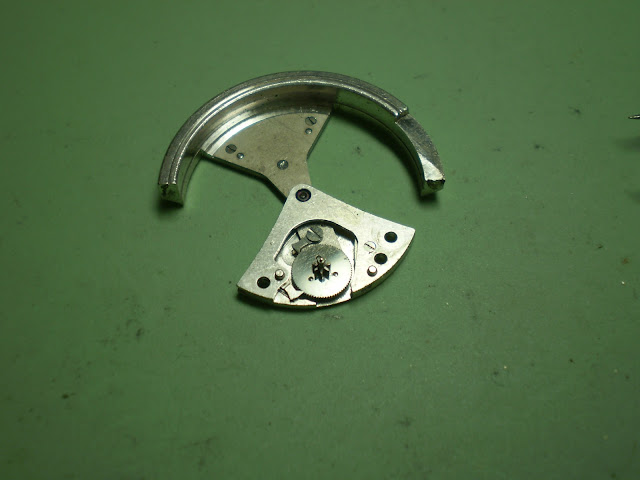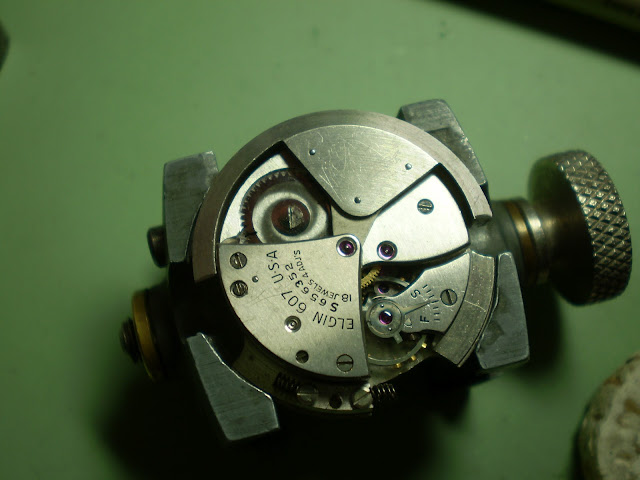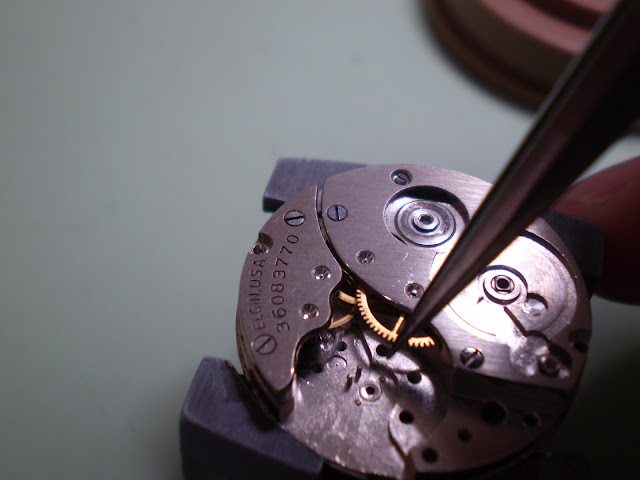Still, my supplies of spare balances in good condition has been dwindling over time, and for some families of movements, I simply have none. At the same time, I've built up a backlog of balances that have good balance wheels, hairsprings, and roller tables, but have one or both pivots broken.
One thing that stopped me was my lack of a staking set. Staking sets are de rigeur for any kind of serious watch work beyond simply cleaning and oiling. And they generally go for a significant chunk of change. For a long time, this stopped me. Fortunately, Cary Hurt, a highly respected collector, came to my rescue, offering to swap me a staking set for my servicing a handful of his watches. It was an offer I couldn't refuse, but I think I got much the better part of that deal!!
I obtained New Old Stock (NOS) Elgin balance staffs for most of the watches I collect, and with the arrival of the staking set from Cary, and a K&D Balance Staff Remover, I was set. For my first restaffing, I decided to do an Elgin 555 given to me as a project by Scott Allison of Times of Plenty, a dealer in NOS vintage watch bands and bracelets. I had taken down and cleaned the rest of the movement some time ago, discovering right off the bat that the balance pivots were both gone...
What I had not noticed was that the roller jewel was also absent. So I found ANOTHER busted Elgin 554 series balance with a GOOD roller table. You can see the roller jewel, right where it should be....
Before removing the old staff, you first have to remove the hairspring and roller table. To remove the hairspring, I made myself a homemade collet tool. I took a heavy gauge sewing needle and stoned it down to a long, thin wedge with a flat tip, like a screwdriver. I chucked it up in my pinvise, to give me a handle to hold. The thin end of the wedge is inserted into the slot in the collet right up against the staff, and then turned while lifting, to lift the collet off.
This didn't work for this balance, for reasons I later discovered*. So, I ended up using another approach - I inserted the tool underneath the hairspring and gently pried up on the collet till it came off. This needs to be done VERY CAREFULLY! But then, everything in this procedure does, too.
Once the hairspring is off and safely stowed, it's time to remove the roller. The staking set has a roller remove. This tool fits into the riveting plate of the staking set, then you place the fingers over the balance arms, and under the roller table, and tighten until it's held in place.
Then, you select a pivot punch that just fits the cone of the balance staff tip, use it to center the work, and lock the riveting table in place.
A few light taps will push the balance off the roller.
Next, find the smallest hole in the rivetting table that holds the hub without binding.
Use the centering punch to center the work, and lock the table in place. Now it's time to get your staff remover. This is a tool that fits in the space between the gooseneck and the rivetting table, and clamps the balance arms down, so they THEORETICALLY won't be deformed when the staff is knocked out**.
The large knurled part unscrews all the way up to the gooseneck, then the stem of the smaller knurled part is used to clamp the tool down. Before you do that, though, you need to push the stake down through the goosneck and the remover, to make sure it's all lined up perfectly. There's a window to check that the stake is run down all the way to the balance pivot.
With everything clamped in place, a single, sharp hammer blow should drive the staff out, shearing off the rivet and leaving the balance wheel THEORETICALLY unharmed.
Sometimes, theory and practice are the same! See the little ring? That's the rivet.
The old, busted staff is still useful! You use it to find flat nose and round nose hollow punches that will JUST fit over the collet side of the staff without binding.
Next you use it to find a hole in the rivetting table that will JUST hold the staff below the hub without binding. Use the center punch to center it, and lock the table in place. Insert your NEW staff in the balance wheel, making sure the rivet stands above the balance arms, and place it in the hole in the table.
Now, lower the round faced punch down to the work. At this point you may need to adjust the centering - I did!. Gently slide the punch down over the staff to the rivet.
Strike the punch with a series of blows, turning the punch a little after each blow. Using tweezers, and holding the punch down firmly so it doesn't turn, grasp the rim of the wheel and try to turn it. If it turns, you need to repeat, but striking harder, until the balance is held in place by the staff, indicating the rivet is has been rolled over and is holding the balance to the staff.
Once that's done, replace the round faced punch with the flat faced one, and flatten down the rivet.
Next, I tested the balance for how freely it would spin in the movement. With the pallet and train bridges removed, I installed the newly staffed balance, sans roller and hairspring, in the movement.
Using a brush or a blower, start the balance spinning...
It should spin freely for a LONG time, only very gradually slowing to a stop. Ideally, there should be no sound of rubbing or other interference.
Time to install the roller table! First, place the roller over the roller post. It should come most of , but not all the way down to the hub. Align the roller jewel perpendicular to the arms, place the lower pivot in the same hold you used for riveting. Now, put yourself in a position to see the gap between the roller table and the hub, and while watching this gap LIKE A HAWK!, gently drive the balance down onto the roller with VERY light blows, stopping as soon as the gap disappears.
Now to true the balance! I have an old K&D truing caliper, and I gently place the balance into the side which grasps the cones of the staff tips. Tighten down carefully until the balance is free to move, but doesn't spin freely. Adjust the indicator close to the rim of the balance, and as you slowly rotate the balance, observe whether the width of the gap changes.
In my case, one side was higher. I pushed down in that side slightly, since the Elgin Manual says not to push UP lest you pop your wheel off the staff. A few nudges, and the balance was trued in the flat. I also checked it in the round, but since it's a solid balance that was not an issue.
For the next part - poising - I used the other side of the calipers, the side with holes that hold the pivots***. The balance should spin freely, but stand still at any point you stop it. Mind did.
Next, the hairspring is installed. After placing the collet over the hairspring post, a punch is used to gently push the collet down to the hub.
Now the balance is restaffed, trued, and poised! Time to put the movement back together!!
And...
And...
IT'S ALIVE!!!!
* It turned out the collet was loose on the staff, which is why trying to spin it off didn't work. I discovered this when I tried to adjust the beat - how close the roller jewel is to perfect alignment with between the balance and the pallet pivots when at rest.
I found that the amplitude was changing as I watched, and when I tried to turn the collet, it moved too freely. I removed the hairspring, placed it on my bench block, and used a concave punch JUST larger than the collet. A few light hammer blows tightened it right back up.
** REAL watchmakers almost without exception are trained to use a lathe to cut the balance off the staff from the hub side. This is less likely to cause deformation of the balance arms, and is over all much gentler on the balance. Then again, a lathe makes staking set look cheap!
*** I am reliably informed that a truing caliper is pretty much useless for poising, and that one should use a poising tool. These are not expensive, and I now have one. Another alternative is to place the balance with the roller table in the movement (without the pallet and train bridge), turn it sideways, and see if the balance tries to roll to the same point, or if it will stand at whatever point you stop it.

























































